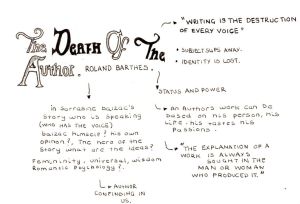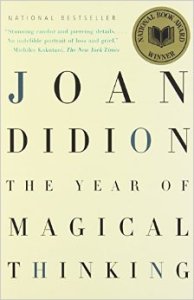Phelan, James. “The Implied Author, Deficient Narration, and Nonfiction Narrative: Or, What’s Off-Kilter in The Year of Magical Thinking and The Diving Bell and the Butterfly?” Style 45.1 (Spring 2011): 119-137. Print.

Barthes contention of “the death of the author” was introduced alongside “The Intentional Fallacy” and New Criticism’s concerns with “the text itself.” See footnote #1.
A discussion of rhetorical narrative theory must include an examination of its place within a large body of historical and modern literary theory. In so doing, it is appropriate to recognize the curious position of rhetorical narrative theory, which historically builds upon neo-Aristotelian and the Chicago School of literary criticism, as one that seems to invite equal parts passionate advocacy and critical questioning of its legitimacy. The position and application of rhetorical narrative theory includes discussion and debates around the implied author, the function of the narrator, and calls into question issues of intertextuality and intentionality, sometimes referred to as “the Intentional Fallacy.[1]”
In large part, this article addresses many of the arguments against rhetorical narrative theory, and offers mainly the hypothesis that rhet-narrative theory should exist alongside these other theories because it adds a certain value that enriches our understanding of literary texts, including nonfiction texts. Phelan specifically addresses not only arguments that favor theories such as that our readings of texts are “mediated by our interpretive frameworks” with the view that “texts have an existence independent of those frameworks” (123). In addition, Phelan addresses the value of deconstruction as a theory that essentially rules out authorial intention because “language always undoes itself,” and again insists that rhetorical theory analysis of a text allows us to understand deeper contexts like irony and cultural contexts[2] (124).
Discussion is given to the relationship between Phelan’s argument for the legitimacy in analyzing intention and the theoretical analysis of the implied author, which argues that the implied author better positions intentionality because it considers authorial choice of “technique, subject matter, narrative sequence, ethical values, and so on;” considers differences in “ideological or ethical positions in texts by the same biological author;” illuminates differences between the real author’s discussion of her own text and the implied author’s “purposeful design governing the text;” and “our sense that we know an author through reading his or her text and that the author has a life independent of the identity projected in the text” (128). This gives the implied author an agency within the text that counters theory that treats the implied author as passively produced by the text or by reader interpretation.

Joan Didion’s memoir, The Year of Magical Thinking, is used by Phelan as an example of the deficiency of the narrating-I, the experiencing-I, and the implied author when considering reliability.
In the final pages of this article, Phelan turns his analytical eye to applying rhetorical narrative theory to nonfiction, specifically Joan Didion’s memoir The Year of Magical Thinking and Jean-Dominique Bauby’s The Diving Bell and the Butterfly. Phelan outlines five proposals to argue that his analyses of both texts reveal off-kilter narration between the narrating-I, the experiencing-I, and the implied author. The main theme of these five proposals build on Phelan’s argument that, rather than the unreliability of the narrator, these examples show the deficiency of some narration, most revealed in analyses of the nonfiction memoir, because of the “factual status of the narrative” (133).
***********************
[1] James Phelan describes the emergence of the “Intentional Fallacy” in 1946, forwarded by scholars on theory established by W.K. Wimsatt and Monroe Beardsley in the essay “The Intentional Fallacy,” which deliberately marginalizes and ignores the real author’s purpose and influence on any interpretation of her text. Phelan also summarizes subsequent work which coincided and endured with the rise and fall of New Criticism, including Barthes “death of the author,” and Stanley Fish’s argument that “the interpretive strategies of interpretive communities dictate the meaning of texts, then interpretive authority rests entirely with those communities — authors are essentially irrelevant” (122).
[2] Phelan uses Jane Austen’s famous first line in Pride and Prejudice, “It is a truth universally acknowledged that a single man in possession of a good fortune must be in want of a wife,” to illustrate how a simple deconstructive reading of this line would only cause us to question language, when intention would reveal the deliberate irony caused by “he movement of the sentence from its initial signaling of some grand wisdom (not just “A universally acknowledged truth is” but “It is a truth universally acknowledged that”) to its final delivery of a dubious proposition” (124).
